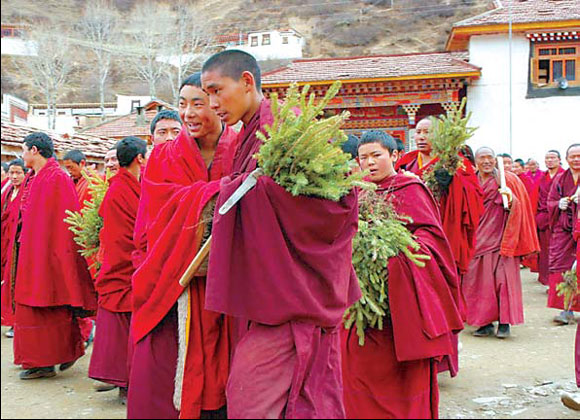
Lamas from a monastery in Aba county, Gansu province, set off to plant trees as a way to express their good wish to a successful Beijing Olympic Games.
Lamas in red cassocks chanted sutras in the Tibetan language at Puning Monastery, Hebei province, in a prayer for peace for the whole nation.
"The violence in Tibet shocked me. I feel heartbroken for the people in cassocks who lost their better nature and carried out the unrest," Meri Gentu, deputy abbot of Puning Monastery, built in 1755, during the Qing Dynasty (1644-1911), said.
The grand monastery, which bears the name "worldwide peace", resounded with sublime chanting voices. Dozens of lamas crossed their legs, sitting face to face in the main hall, under the giant Buddha figures. A few laymen kowtowed and received blessings from the lamas.
"We pray for the peace of the whole nation," Tunglaga, 40, the chamberlain of the monastery, said after the daily service.
The monastery is one of 12 temples built by Aisin-Gioro Hung Li, the fourth emperor of the Qing Dynasty, around his Chengde summer resort. It stands as proof of ethnic solidarity between Tibetans, Mongolians and Hans, Tunglaga said.
At that time, there were eight temples of lamas who received financial support from the Qing court. Puning Monastery, with the longest history, is currently the biggest lamasery in northern China.
Since then, the chanting voice of sutras has never stopped here. Great buddhist events resumed from the 1980s on. About two big ceremonies and 40 small events are held annually, Tunglaga said.
Last July he witnessed the first arrival of the 11th Panchen Lama Gyaincain Norbu.
Puning Monastery has a long history with the Panchen, since the sixth Panchen Lama come here from Tibet to celebrate the emperor's birthday in 1780, he said.
The monastery began to invite Buddhist dignitaries to hold religious ceremonies for local people in 2006.
Two grand Buddhist ceremonies have been held annually since then.
The tradition of free religious belief was passed down while living conditions have been improving, Tunglaga said.
The local government gave 10 million yuan ($1.4 million) to the 80 lamas to build a residential building, neighboring the 200-year-old monastery, Wang Hui, deputy director of Chengde municipal ethnic and religion bureau, said.
Better living conditions guarantee better learning, Losang Shiqung, a 45-year-old Tibetan lama from Qinghai province, said. Now he is a teacher of the young monks.
"Study will never stop until I become a Buddha, and praying for the victims will never stop until the violence ceases," he said, counting Buddha beads.
(Xinhua News Agency April 18, 2008)